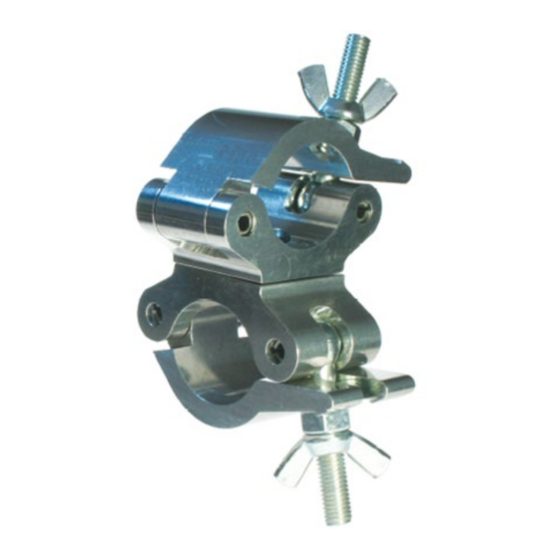
Table of Contents
Advertisement
Quick Links
Engineering Ltd
Doughty Low Profile Clamps
User Manual
IMPORTANT – READ CAREFULLY BEFORE USE – KEEP FOR FUTURE REFERENCE
User Manual Revision A Issued January 2018
Doughty Engineering Ltd
Crow Arch Lane, Ringwood, Hampshire BH24 1NZ
Tel: +44 (0) 1425 478961
sales@doughty-engineering.co.uk
www.doughty-engineering.co.uk
Doughty Low Profile Clamp User Manual Revision A
Original User Manual
Page 1 of 18
Advertisement
Table of Contents

Summary of Contents for Doughty Engineering T57230
- Page 1 Doughty Low Profile Clamps User Manual IMPORTANT – READ CAREFULLY BEFORE USE – KEEP FOR FUTURE REFERENCE User Manual Revision A Issued January 2018 Doughty Engineering Ltd Crow Arch Lane, Ringwood, Hampshire BH24 1NZ Tel: +44 (0) 1425 478961 sales@doughty-engineering.co.uk www.doughty-engineering.co.uk...
-
Page 2: Table Of Contents
Contents SAFETY NOTES........................... 3 GENERAL ............................3 SCOPE ............................4 LIMITATIONS OF USE ........................ 4 IDENTIFICATION OF THE PRODUCT ..................6 MODIFICATION ..........................7 SAFETY INFORMATION ......................7 COMPLIANCE ..........................10 TRANSPORT AND STORAGE ....................11 INSTALLATION ........................... 11 10. COMMISSIONING ........................13 11. -
Page 3: Safety Notes
SAFETY NOTES BEFORE installing and operating clamps, please read this manual carefully and pay attention to the information provided. Use this manual to familiarise yourself with the clamp, its proper use and safety regulations. DANGER: Indicates a hazardous situation which, if not avoided, will result in death or serious injury. -
Page 4: Scope
Doughty has endeavoured to deliver the highest degree of accuracy possible. However, continuous improvement of our products is a Doughty Policy. Therefore, product specifications are subject to change without notice. Readers and users are encouraged to notify Doughty of errors and send in suggestions for improvement. - Page 5 Rated Load with a Safety Factor of 5:1 WLL 2006/42/ES for Static Load WLL1 (KG) WLL2 (KG) PART NO TUBE DIA DESCRIPTION FINISH ACCESSORY LIFTING (CE) STATIC T57230 48-51 Low Profile Weld Coupler Polished None T58600 48-51 Low Profile Hook Clamp Polished None...
-
Page 6: Identification Of The Product
4. IDENTIFICATION OF THE PRODUCT TYPICAL DOUGHTY LOW PROFILE CLAMP & COUPLER Doughty Low Profile Clamp User Manual Revision A Original User Manual Page 6 of 18... -
Page 7: Modification
TYPICAL DOUGHTY LOW PROFILE CLAMP LABEL 5. MODIFICATION The following modifications are allowed to be executed by third parties. Nut replacement: The standard nut and wing-nut shall be replaced by a self-locking nut when Loads are predominantly dynamic. • • Loads are moving and change position. - Page 8 DO NOT lift loads above people without the following precautions Use a Self-locking nut instead of the wingnuts on the eye bolts when loads are predominantly dynamic and loads are moving and change position. Clamps shall be solely used for the range of pipe diameters as stated on the clamp. The use of a clamp on other diameter pipes will lower the working load limit.
- Page 9 USING CLAMPS WHERE THE DIRECTION OF LOAD IS PARALLEL TO THE TUBE DEPENDS ON, BUT NOT LIMITED TO, CONTACT SURFACE, MATERIAL, FRICTION RESISTANCE AND THE APPLIED TORQUE TO THE CLAMP’S WINGNUT / NUT. THIS TYPE OF APPLICATION SIGNIFICANTLY REDUCES THE STATED WLL AND SHOULD BE USED WITH EXTREME CAUTION.
-
Page 10: Compliance
Do not use fixings that, when tightened, will contact the tube or barrel on which the clamp is fixed as highlighted above. 7. COMPLIANCE CLAMPS USED AS LIFTING ASSESSORY: 2006/42/EC Machinery directive DGUV Regulations for stages and studios (Formerly known as BGVc1) Rules 115-002 DGUV Information 215-313 Safety at productions and events for television, radio, film, theatre, exhibitions: Loads above persons (Formerly known as... -
Page 11: Transport And Storage
8. TRANSPORT AND STORAGE • Due to the relatively high self-weight it is advised to keep storage bins as small as possible in such a manner they can be lifted by one person. Local legislation for maximum load to be lifted by persons shall be adhered to. •... - Page 12 e. Fold the eye bolt and lid aside. Hang the clamp in the desired position. Tighten the bolt before the load is fully supported. g. Tighten the wingnut / nut / bolt by hand or using a 19mm spanner. Firmly hand tight should be enough.
-
Page 13: Commissioning
COMMISSIONING Before applying a load check that all connections are properly made. Before lifting check that all connections are still correct. Check if all parts are in good order. DISSASSEMBLY INSTRUCTION 1. Take the weight of the clamp. 2. Release the nut and fold the eye bolt aside. 3. - Page 14 14.1 INITIAL INSPECTIONS When first acquired, whether they are new or used, clamps should be inspected in accordance with Table 14 and a record of the inspection maintained. REGULAR INSPECTIONS Regular visual inspections should be carried out in accordance with Table 14. Regular inspections should be performed by a competent person and should be carried out prior to each incident of use.
-
Page 15: Maintenance
MAINTENANCE Although under normal use and environmental circumstances, clamps need little maintenance, for safety reasons, all parts must be checked regularly for damage, cracks and corrosion. The Clamp shall be checked in compliance with the local law by a competent person. Checking shall take place as often as required but at a minimum of once a year. -
Page 16: Warranty
WARRANTY • For a period of 12 months we undertake to repair, free of charge any damage attributable to faulty materials or workmanship, provided that the appliance is forwarded, freight paid, to our works or one of the Doughty appointed service agents. The guarantee-period begins on the day of the delivery, proven by a purchase receipt •... -
Page 17: Inspection List
INSPECTION LIST ITEM FAULT REPAIR DATE SIGNATURE Doughty Low Profile Clamp User Manual Revision A Original User Manual Page 17 of 18... -
Page 18: Ec Declaration
EC DECLARATION Doughty Low Profile Clamp User Manual Revision A Original User Manual Page 18 of 18...
Need help?
Do you have a question about the T57230 and is the answer not in the manual?
Questions and answers